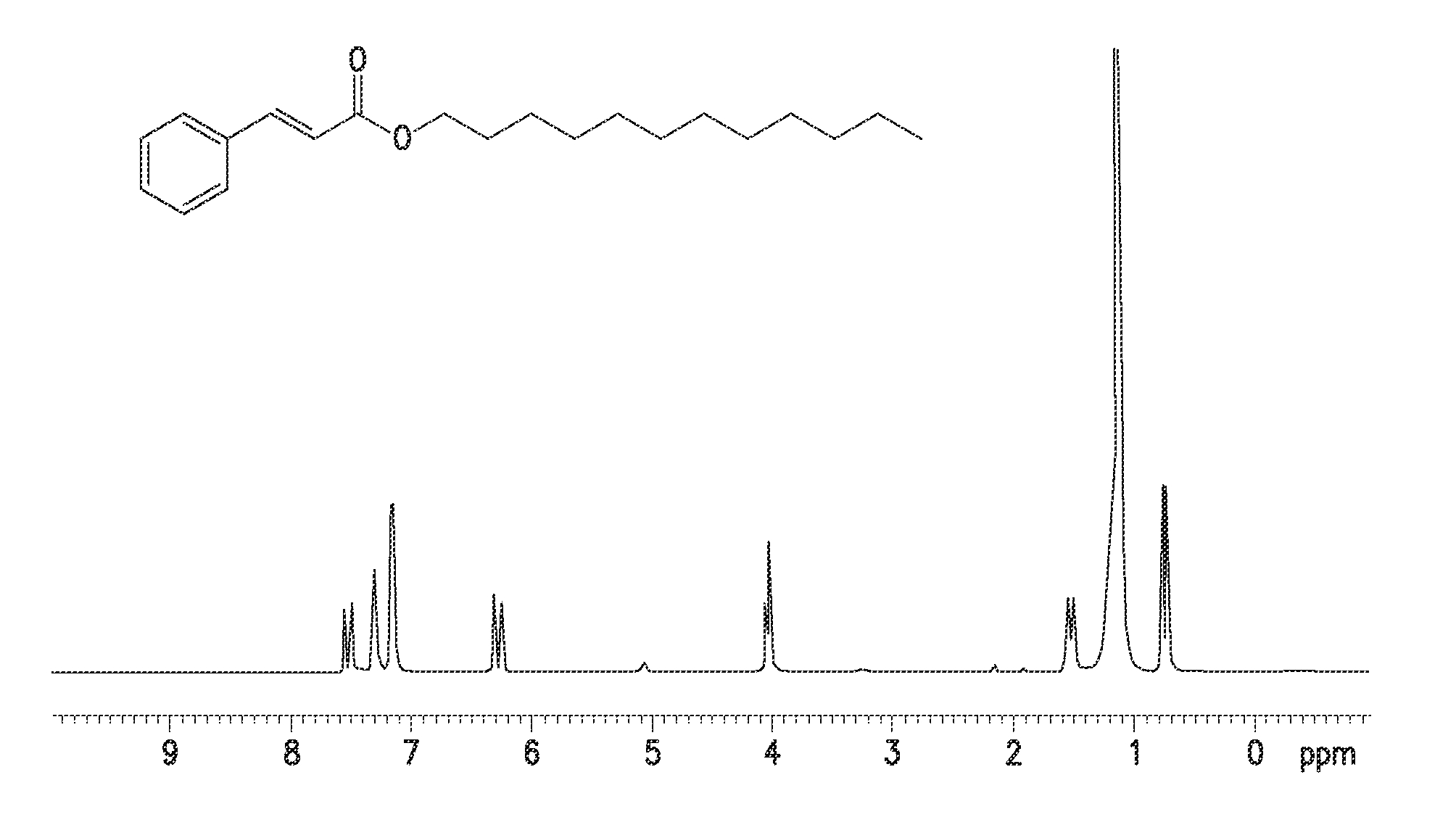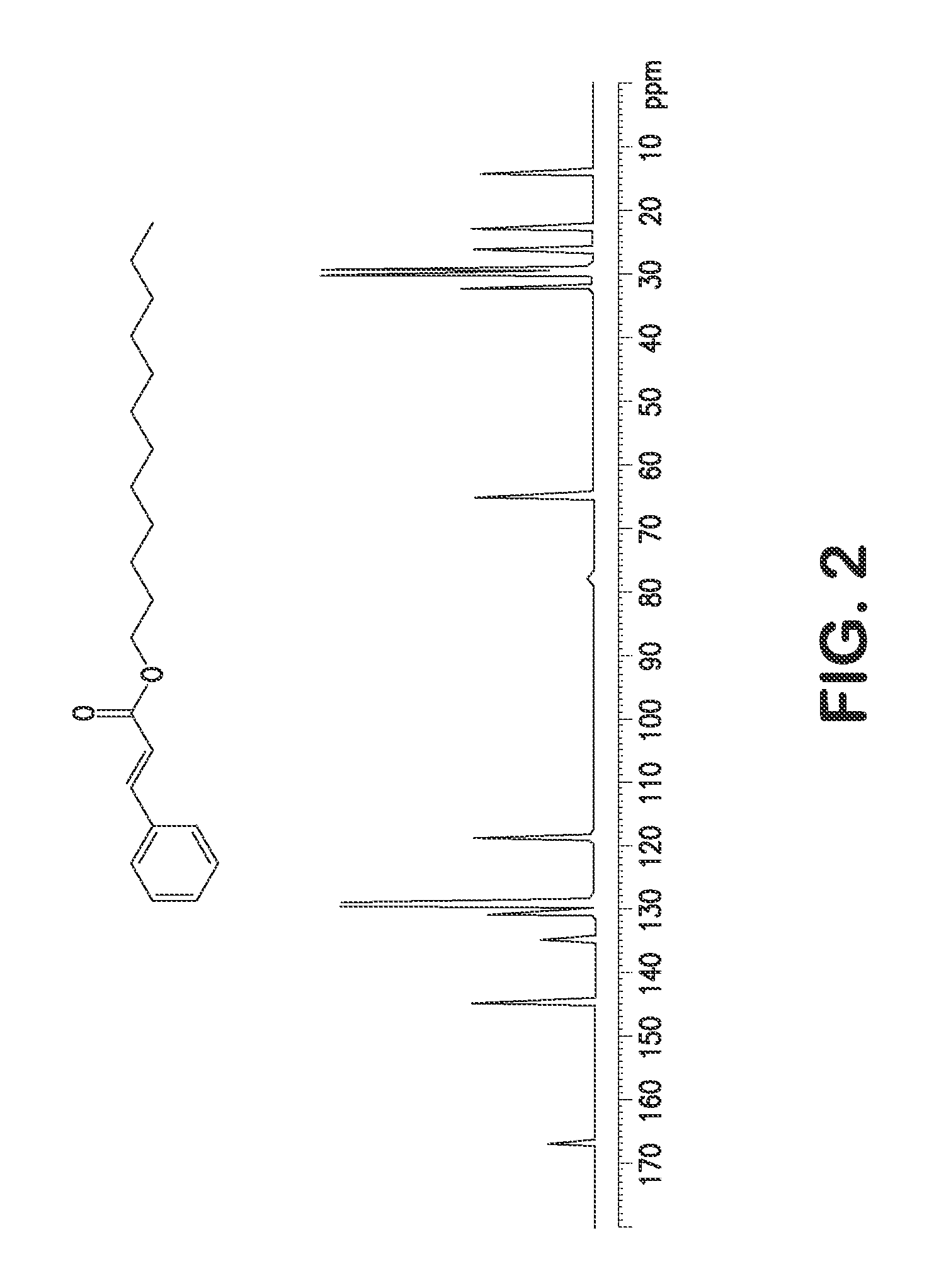Single step green process for the preparation of substituted cinnamic esters with trans-selectivity
a technology of cinnamic esters and green processes, which is applied in the preparation of carboxylic acid esters, chemistry apparatus and processes, and processes. it can solve the problems of invariably long reaction completion time, process suffers from the use of highly inflammable sodium, and method limitation for a number of substituted benzaldehydes, etc., and achieves the effect of enormous flavor importan
- Summary
- Abstract
- Description
- Claims
- Application Information
AI Technical Summary
Benefits of technology
Problems solved by technology
Method used
Image
Examples
example 1
Method for the Preparation of Methyl Cinnamate From Cinnamaldehyde Using Conventional Method (At Room Temperature)
[0085] A homogeneous mixture containing cinnamaldehyde (7.5 mmol), DDQ (11.3 mmol), MeOH (15 mL) is taken in a round bottom flask and catalytic amount of amberlyst® 15 (0.1 g) is added to it. The mixture is stirred for 20 hrs at room temperature. After completion of the reaction (observed by TLC and GC analysis), the reaction mixture is filtered and washed with MeOH (5 ml×2). Concentrate the filtrate under reduced pressure and the crude product thus obtained is loaded on a neutral alumina column and eluted with diethyl ether. Methyl cinnamate (from formula I where X1═H, X2═H, X3═H, X4═H, X5═H, R═CH3) is isolated in 98% yield. 1H-NMR (CDCl3, 300 MHz) δ7.56 (1H, d, J=16.55 Hz), 7.34 (2H, m), 7.21 (3H, m), 6.31 (1H, d, J=16.55 Hz), 3.64 (3H, s); 13C-NMR (CDCl3, 75.4 MHz) δ167.2, 144.7, 134.3, 130.2, 128.8, 128.0, 117.8, 51.5.
example 2
Method for the Preparation of Methyl Cinnamate From Cinnamyl Alcohol Using Conventional Method (At Room Temperature)
[0086] A homogeneous mixture containing cinnamyl alcohol (7.5 mmol), DDQ (22.5 mmol), MeOH (20 mL) is taken in a round bottom flask and catalytic amount of amberlyst® 15 (0.1 g) is added to it. The mixture is stirred for 20 hrs at room temperature. After completion of the reaction (observed by TLC and by GC analysis), the reaction mixture is filtered and washed with MeOH (5 ml×2). Concentrate the filtrate under reduced pressure and the crude product thus obtained is loaded on a neutral alumina column and eluted with diethyl ether. Methyl cinnamate is isolated in 86% yield whose NMR values are found matching with reported values as in example 1.
example 3
Method for the Preparation of Methyl Alpha Methyl Cinnamate From Cinnamaldehyde Using Conventional Method (At Room Temperature)
[0087] A homogeneous mixture containing alpha methyl cinnamaldehyde (7.5 mmol), DDQ (11.3 mmol), MeOH (15 mL) is taken in a round bottom flask and catalytic amount of acidic alumina 15 (0.1 g) is added to it. The mixture is stirred for 20 hrs at room temperature. After completion of the reaction (observed by TLC and GC analysis), the reaction mixture is filtered and washed with MeOH (5 ml×2). Concentrate the filtrate under reduced pressure and the crude product thus obtained is loaded on a neutral alumina column and eluted with diethyl ether. Methyl alpha methyl cinnamate (from formula I where X1═H, X2═H, X3═H, X4═H, X5═H, R═CH3) is isolated in 55% yield. 1H-NMR (CDCl3, 300 MHz) δ7.61 (1H, s), 7.23 (5H, m), 3.69 (3H, s), 2.05 (3H, s); 13C-NMR (CDCl3, 75.4 MHz) δ168.9, 138.9, 135.8, 129.6, 128.3, 51.3, 14.0.
PUM
| Property | Measurement | Unit |
|---|---|---|
| frequency | aaaaa | aaaaa |
| frequency | aaaaa | aaaaa |
| temperature | aaaaa | aaaaa |
Abstract
Description
Claims
Application Information
 Login to View More
Login to View More - R&D
- Intellectual Property
- Life Sciences
- Materials
- Tech Scout
- Unparalleled Data Quality
- Higher Quality Content
- 60% Fewer Hallucinations
Browse by: Latest US Patents, China's latest patents, Technical Efficacy Thesaurus, Application Domain, Technology Topic, Popular Technical Reports.
© 2025 PatSnap. All rights reserved.Legal|Privacy policy|Modern Slavery Act Transparency Statement|Sitemap|About US| Contact US: help@patsnap.com



